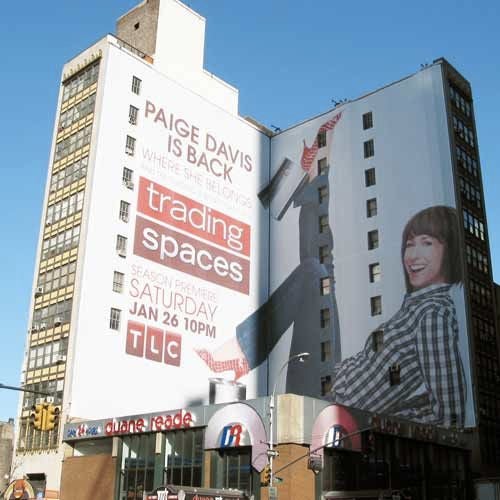A deeper look at the Market East signage flap
Feb. 26, 2010
By Kellie Patrick Gates
For PlanPhilly
First District Councilman Frank DiCicco says his proposal to allow for bigger, flashier signs on East Market Street could help revive an important part of Center City.
Right now, DiCicco said, Market East is a “dead zone after 5 o’clock. The street dies.” No city can live up to its potential if a street in its heart goes silent in the evening, he said.
Mary Tracy, executive director of SCRUB, an organization that fights blight in public spaces, agrees Market East needs help. “I applaud the councilman for saying, ‘let’s take a look at Market Street,’” she said.
But Tracy believes the reduced sign restrictions contained in the bill would have a huge consequence: Severely hampering the ability of the city or concerned citizens to prevent just about any billboard from going up anywhere in the city.
DiCicco said he’s open to suggestions, and the bill he introduced to City Council in January, No. 100013, is just meant to start the conversation. “I want to look at what is currently permitted on Market Street and see if any adjustments need to be made to move forward.”
DiCicco brings up the Gallery as an example of a structure that might benefit from some adjustments. Even before Foxwood’s now abandoned plan to move to the Gallery, the Pennsylvania Real Estate Investment Trust was working on a plan to spruce up the place. The city planning department is also working on a plan for the Market East corridor, with New York architecture firm Ehrenkrantz, Eckstut & Kuhn, and part of it includes making big, blank walls more accessible to people on the street.
“Signage can be a component of bringing people in,” DiCicco said.
The Councilman said the bill has a specific target, creating a commercial advertising district on Market St. between 7th and 13th. He said it won’t change any rules elsewhere in the city, unless another such district is created.
And even within those boundaries, he said, he’s not looking to create a “billboard boulevard.” In a letter sent to concerned citizens who contacted him about the proposal, he points to language in the legislation that requires signs to be 300 feet apart, and 500 feet away from a residental area, among other restrictions.
The legislation does contain language that specifies the new rules would apply only to the area within a special district on Market Street.

But it also calls for removing an entire section, called the legislative findings, from the city zoning code. This is what really has Tracy and Stacey Graham, SCRUB’s legal council, concerned.
Those findings include the following:
• “The excessive number of commercial outdoor advertising signs contribute to visual clutter and detract from the aesthetic beauty of the City of Philadelphia.”
• “Said signs jeopardize public safety by distracting pedestrians and to a greater extent passing motorists, since these signs by their nature are erected in areas intended to be seen by drivers of motor vehicles.”
The findings also address illegal billboards being used to disproportionately advertise alcohol and cigarettes in poor neighborhoods.
In his letter, DiCicco says the findings are too broad, condemning all advertising, and that legislative findings are generally “unnecessary and unenforceable.”
Not so, said Graham. “Without the legislative findings, you just have sign controls, which is governmental interference with speech. It’s actually governmental censorship,” she said.
“The government cannot censor without legitimate purpose, and the legislative findings equal that purpose.”
Graham said the courts commonly refer to a 1966 Pennsylvania Supreme Court case involving the Ammon R. Smith Auto Company. A township attempted to prohibit electronic signs throughout its boundaries, and the court said that was too broad and unreasonable, and the law lacked any justification for prohibiting such signs.
She said that SCRUB has used the findings within the Philadelphia zoning code related to signs to fight off billboards in the past. She pointed to a 2004 Commonwealth Court decision in which the court overturned the Zoning Board of Adjustment’s decision to allow a billboard at the former Frankford Arsenal. “Because … legislative findings were well articulated through the zoning code, the court found that the ZBA’s issuance of a variance was in violation of public policy,” she said.
Tracy said DiCicco should bring in experts to review the sign ordinance before it is acted upon.
DiCicco said he is open to further discussion.
In addition to the findings issue, Tracy is also concerned that the legislation could work counter to DiCicco’s goal to foster development on Market Street. She thinks owners of empty buildings would be content to wrap them in advertising and collect the rent without otherwise doing a thing.
DiCicco said he has seen that kind of thing along I-95, and the bill would not allow that. Buildings would have to be occupied in order for signs to be allowed, he said.
The bill has been sent to Council’s rules committee. No public hearing date has been set yet.
Read Inga Saffron’s take on Market East
Contact the reporter at kelliespatrick@gmail.com
WHYY is your source for fact-based, in-depth journalism and information. As a nonprofit organization, we rely on financial support from readers like you. Please give today.







